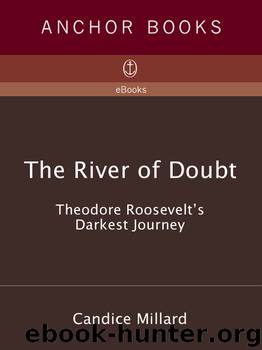The River of Doubt by Candice Millard

Author:Candice Millard [Millard, Candice]
Language: eng
Format: epub, mobi, pdf
ISBN: 978-0-307-57508-1
Publisher: Knopf Doubleday Publishing Group
Published: 2005-03-25T16:00:00+00:00
CHAPTER 19
The Wide Belts
BY ROUGHLY TWO MILLION years ago, humans had spread out of Africa and into Europe and Asia. Hundreds of thousands of years later, they migrated to Australia and New Guinea, which were then connected as a single continent. Because they did not yet have boats and could not endure the cruel cold of Siberia, tens of thousands of years more passed before they crossed the Bering Land Bridge and made their way into the Americas. When they finally began to populate North America, however, human beings quickly dispersed throughout the continent and, by crossing the Panamanian Land Bridge, soon reached South America. Some twelve thousand years ago, they entered the Amazon.
In the eyes of the rest of the world, the humans who reached the Amazon Basin virtually disappeared. For thousands of years, there was no further contact with the Amazonians. Whereas most regions of the world continued to change and interact, to form new peoples and nations by fusing races and cultures, the inhabitants of the Amazon remained insular and isolated. Even in 1500, when European explorers began to land on the shores of South America, claiming the land for themselves and their kings and enslaving its aboriginal inhabitants, the continent’s vast interior remained untouched and its people unknown and unreachable.
After the Spanish explorer Orellana finally penetrated the Amazon Basin in 1542, he returned with startling tales of dense jungles, deadly poisons, and, most astonishing of all, a tribe of vicious women warriors. The expedition’s chronicler, the Dominican friar Gaspar de Carvajal, described the women as going “about naked but with their privy parts covered, with their bows and arrows in their hands, doing as much fighting as ten Indian men.” Orellana named these women the Amazons, after the famed women warriors of Greek mythology, who were said to have removed their right breast so that they could more effectively shoot a bow and arrow. It is from the Greek word a-mazos, or “no breast,” that the word “Amazon” is derived.
After Orellana, few outsiders disturbed the Amazon’s native peoples for the next two hundred years. In the mid-eighteenth century, however, things changed dramatically and, for the Amazon’s human inhabitants, disastrously. While traveling down the Amazon River from Ecuador, the French naturalist and mathematician Charles-Marie de La Condamine saw natives extracting a milky substance from a tall tree. After the strange liquid, which the Indians called caoutchouc, had coagulated, it was used to make everything from boots to bottles. La Condamine saw potential in caoutchouc and brought a sample with him back to France. When the strange, pliable substance made its way across the channel, the British soon discovered that it worked extremely well as an eraser, and so began referring to it as “rubber.” By the end of the eighteenth century, rubber was well known and widely used throughout Europe and the New World. By the middle of the nineteenth century, the Amazon was exporting more than 150 metric tons of it each year.
La Condamine’s discovery meant
Download
The River of Doubt by Candice Millard.mobi
The River of Doubt by Candice Millard.pdf
This site does not store any files on its server. We only index and link to content provided by other sites. Please contact the content providers to delete copyright contents if any and email us, we'll remove relevant links or contents immediately.
| American Revolution | Civil War |
| US Presidents |
Fanny Burney by Claire Harman(25790)
Empire of the Sikhs by Patwant Singh(22183)
Out of India by Michael Foss(16314)
Leonardo da Vinci by Walter Isaacson(11914)
Small Great Things by Jodi Picoult(6106)
The Six Wives Of Henry VIII (WOMEN IN HISTORY) by Fraser Antonia(4797)
The Wind in My Hair by Masih Alinejad(4427)
The Lonely City by Olivia Laing(4122)
The Crown by Robert Lacey(4113)
A Higher Loyalty: Truth, Lies, and Leadership by James Comey(4038)
The Iron Duke by The Iron Duke(3649)
Millionaire: The Philanderer, Gambler, and Duelist Who Invented Modern Finance by Janet Gleeson(3574)
Sticky Fingers by Joe Hagan(3456)
Alive: The Story of the Andes Survivors by Piers Paul Read(3318)
Papillon (English) by Henri Charrière(3278)
Joan of Arc by Mary Gordon(3264)
Stalin by Stephen Kotkin(3089)
Aleister Crowley: The Biography by Tobias Churton(3025)
Ants Among Elephants by Sujatha Gidla(2928)
